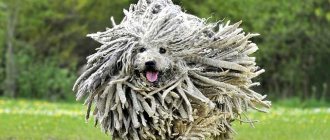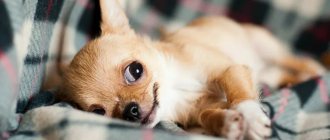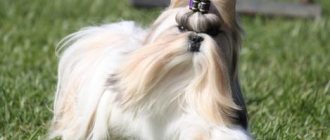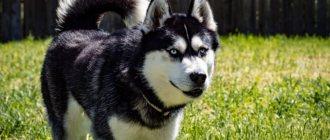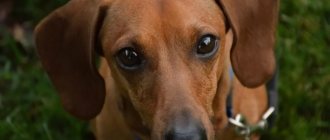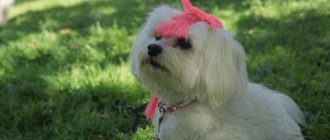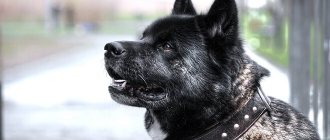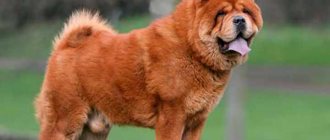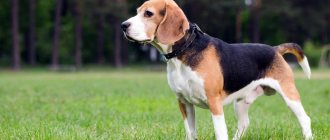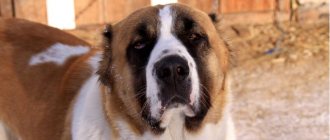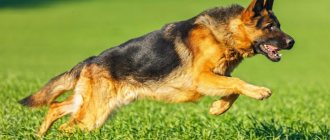Italian dog breeding has a long history, during which over a dozen dog breeds have been developed that are recognized throughout the world.
The Roman Empire laid the foundations for large guard breeds, the Middle Ages promoted the development of hunting branches of dog breeding, and the court nobility lobbied for the interests of compact companion dogs. Italian dog breeds are as old as Europe itself, and their areas of application are unlimited. The Italian Kennel Club not only monitors the preservation of the country's iconic breeds, but also engages in breeding, agility, dog sports and training dogs for social services and the police, and organizes world exhibitions.
Neopolitan Mastiff
This is a fairly powerful and gigantic dog, which impresses with its height of up to 75 cm at the withers and weight of up to 70 kg. This breed dates its history back to the times of the fighting dogs of ancient Rome. This particular breed was bred for protection and protection. But, despite its devotion to the owner and weak aggressiveness, the dog is very dangerous for those who pose a danger. It should not be owned by families with small children, because the animal is heavy and oversized.
Origin story
The Italian Braccus is considered one of the oldest pointing dogs. The first mentions of it were found in the 4th-5th centuries.
What were Bracco Italiano used for?
Australian Kelpie (dog breed): description
Dogs of this breed were most often used in hunting. They became especially popular in the Middle Ages in Italy. These dogs were bred by such celebrities as Medici and Gonzaga. The Italian Braccus is a dog that was often used for bird hunting.
Note! The love for dogs as hunters also increased because they brought game without damaging it at all.
The influence of the Italian Braccus on other types of dogs
The Italian Bracket had a rather serious influence on the development of other breeds of gun dogs. Almost all of the following types take on some of the characteristics of a given dog (German, French Braque, etc.). The only exceptions are quite old breeds - Portuguese Pointer, Weymoraner, Vizsla, and some types of spaniels.
The entry of Italian bracca to the international level
The Fédération Cynologique Internationale recognized the breed in 1956, and the first standard was adopted in 1949 in Italy. The English Kennel Club recognized the Italian Braccus in 2000.
For your information! Clubs in the USA, despite the high popularity of the breed, still do not recognize it and classify it as a rare species.
Popularization of Bracco Italiano
Currently in Italy this breed is the most common of all gun types. The Italian Bracket often appears at sled dog races, various rings and shows, and exhibitions. In 1989, the dogs were brought to the UK. However, recently the breed is often found in the West. Dogs have become very popular in the USA.
The impact of industrialization on Bracco Italiano
The Brakk is a dog breed that was rapidly developing even before the advent of firearms. Bird hunting was very popular in Europe at that time. Falcons and nets were used for this purpose. With the advent of guns, they were no longer needed. However, now the hunters had to look for the killed prey themselves. Hunting dogs were used at that time for flushing and searching for killed game. Therefore, the Italiano Bracco began to be used more often, and the breed gradually became the oldest of the hunting ones.
Italian Bracchis are passionate and love to hunt.
Historical reference
The Cane Corso dog breed is undeniably the heir to the ancient Molossians, to be more precise, the ancient Tibetan Great Danes. Modern Tibetan Mastiffs (Mastiffs) are a breed that has experienced “reincarnation” more than once, but their appearance even today makes people shiver with goosebumps. The first Tibetan Dogo appeared on the Eurasian mainland 1000 years BC, or so the story goes. An aggressive giant trained to catch people was presented as a gift to the ruler of China. Having spread throughout Europe and Asia, Molossians became the ancestors of many modern breeds.
New breeds of dogs have been developed over the centuries to suit the needs of specific territories. The descendants of the Molossians who came to the Roman Empire were also used for their intended purpose - arena battles, military campaigns, and territory protection. Mentions of giants called Corso are found in hunting and baiting chronicles dating back to 1400–1500. It should be noted that in some territories, four-legged animals were used as flock guards. Chroniclers characterize the ancient Cane Corsos as strong, tireless, fearless and loyal dogs.
It is ethical to count the official history of the breed from the times of the prosperity of the Roman Empire. It is this time period that is replete with historical monuments depicting the early Cane Corso in hunting, arenas and fighting. The development of these powerful dogs is continuously intertwined with the history of Italy. Even without delving into cynology references, historical sources tell of giant dogs dressed in armor and lined up in ranks. About dog fights and fights with wild animals. About evil four-legged slave overseers and palace guards.
The Roman Empire fell shortly before the fifth hundred years of our era and a feudal system reigned in Italy. This stage should be considered as a separate step in the formation of the breed. The export of dogs atypical for Italy, for example, Celtic Greyhounds, led to changes and the creation of new progenitors of the breed. Against the backdrop of changes, the already established Italian Cane Corso was widespread throughout the country, especially in the South, where hunting for large wild animals flourished.
With the new regime, dogs began to be used in a new position - guarding farms in the off-season. After the harvest, the land was left under the responsibility of one person and several Cane Corsos. It should be noted that the breed was used for quite a long time as a cattle driver, which also limited contact with the outside world. The echoes of such “professions” were unshakable loyalty to one person - the owner.
The versatile use of Molossians has led to the versatility of modern Cane Corsos. In addition, such powerful dogs were highly valued, which led to a global expansion of the high-quality gene pool. However, history cannot be a straight line; there are always peaks and valleys. The downfall of the breed was the Second World War, the general crisis and the collapse of the economies of many countries. Lack of food and the extermination of “non-front” dogs brought the Cane Corso to the point of extinction and the end of these giants was too close to prevent it.
The revival of the ancient giants is an example of the titanic loyalty and perseverance of one man - Mr. Giovanni Bonatti Nizzoli. Being an educated person, versed in history and facts, the man believed in a miracle and raised the wave of the revival of the Cane Corso. 10 years after the idea was conceived, in 1983, a group of researchers (who were also the founders of the Cane Corso lovers club) literally combed the southern regions of Italy in search of surviving representatives of the breed. By 1987, the first official breed standard was drawn up. The description not only revealed in detail every feature of the ancient giants, but also clearly indicated the differences between the Cane Corso and Mastiffs and Neapolitan Mastiffs in particular.
Before the official opening of breeding registration (1994), more than 500 producers and 700 puppies received positive expert assessment and recognition. Immediately after the recognition of the breed by the Italian Canine Society, the number of dogs exceeded the three thousandth threshold. In 1996, the best producer of Italy with honor defended the reputation of the Cane Corso at the FCI (International Cynological Association) exhibition.
Bolognese, or French lapdog
Well, nothing connects this dog with this breed and the Russian name. Most likely, the kennel club, either out of ignorance or mistakes, gave it such a name. As for the breed itself, it is completely artificial and was bred in the northern part of Italy, namely in the province called Bologna. By nature, they are very attached, sometimes even excessively. Due to the fact that this breed is a purely indoor animal, its dimensions are not significant up to 30 cm, but up to 7 kg. At the same time, care is also appropriate.
1: Bolognese
Italian origin
The Bolognese, named after a city in Northern Italy called Bologna, is an ancient Italian breed with noble roots linking it to the Italian nobility.
Small and white, the breed's closest relative is considered the Maltese, which is also Italian.
The existence of Bolognese can be traced back to the seventeenth century, where it can be seen in early tapestries.
Small in size and downright adorable, this breed was primarily used as a companion dog for the royal family.
Bolognese's Personality and Temperament
The Bolognese is a small toy breed from the Bichon family.
It has a white coat that is described as fluffy and slightly curled.
Because he doesn't shed, this sometimes makes him a portable companion for allergy sufferers (but read our article on hypoallergenic dogs to find out why this can't be guaranteed!)
He loves attention and makes a wonderful companion dog. In fact, this little guy is said to develop a lot.
This is a very active and sociable Italian breed that gets along well with other dogs of all shapes and sizes.
The Bolognese is known to behave like a puppy into old age, which is a plus for active families.
Living Riley's life as a beloved friend.
Although an uncommon breed today, the Bolognese is primarily valued as a pet.
He loves and greatly adores those who have had the honor of owning him.
Health and life expectancy
In general, Italian Braccas are distinguished by good health and live up to 13 years, and sometimes more. The breed is characterized by the development of certain diseases:
- eye diseases;
- ear diseases;
- problems with joints (hip, elbow);
- kidney pathologies;
- gastric volvulus;
- von Willebrand's disease.
Note! With proper care and timely prevention, diseases and other problems can be avoided. It is worth remembering regular vaccination and antiparasitic prevention.
Maremmo-Ambruzzese Shepherd Dog
This is a fairly ancient breed of large dogs that have excessive dignity. They are not aggressive, but have all the necessary guard qualities and are mobile. At the same time, because of their pride, it is better for already experienced people to own such a breed, and this fact must be taken into account when training. The dog's height reaches up to 73 cm and weight up to 45 kg.
Maltese
European origin
He has very few problems, but may be predisposed to hip dysplasia and juvenile epilepsy.
The Maltese is an ancient breed, specially bred for its small size.
He cannot claim pure Italian blood - his pedigree includes dogs from Switzerland and the Mediterranean, including Italy, and, of course, his namesake island of Malta.
Maltese dogs as pets
Interestingly, many believe that this dog was once used to fight rodents, but that was before his appearance and companionship became coveted by the nobility.
The Maltese Dog is a small white dog with a silky coat that can grow very long if properly brushed and groomed.
Its coat can sometimes be curly or wavy, especially if left short. Maltese were bred primarily as companion dogs, so they tend to do well in families and remain lively and playful even into old age.
They love their family members and will be very happy to see them. This is a dog that loves to be with his people all the time!
With that said, the Maltese is known to suffer from separation anxiety, so keep this in mind when leaving him alone for long periods of time.
The elegant Maltese is a renowned companion dog that also does well in shows.
He gets along well with families and adapts to apartment life due to his smaller size.
Health problems and life expectancy
However, since this is a toy breed, we recommend it for families with older children who respect the size of the Maltese.
With a lifespan of 12-15 years, the Maltese dog is a relatively healthy dog.
However, he is more susceptible to severe white shaker syndrome, which is a serious neurological condition.
Lagotto Romagnolo
This breed of dog was mentioned back in the 16th century. This species was highly respected as a hunter on the water. After all, it has a unique impenetrable undercoat, and their sense of smell very often helped in finding truffles. They are loyal and kind towards their family, but they do not particularly like strangers. The growth of such creatures reaches up to 48 kg, and they can gain up to 16 kg in weight.
Nutrition
Italian Braccas are unpretentious eaters . They can eat both premium dry dog food and natural products. If the dog eats natural food, then it is important that it is based on proteins - lean meats, boiled fish. The diet should also include:
- Milk and cottage cheese.
- Eggs.
- Vegetables, greens.
- Porridge (rice, wheat, oatmeal).
The dog must have constant access to drinking water. These dogs are quite gluttonous and if you do not watch the portions, the dog may suffer from obesity.
It is not advisable to feed table scraps, since salt and other spices and seasonings are contraindicated for the dog. Also, the diet should not contain:
- Sweets and pastries.
- Smoked and marinated dishes.
- Tubular bones.
Cane Corso
This is the only completely Italian breed that is 100%. In translation, its name sounds like – protector. According to myths and predictions, this particular dog is depicted in the tombs of ancient Rome. They are kind-hearted by nature, but if they offend their owner or family, then the offender will receive in full. After all, they also carry the blood of gladiator animals, who killed lions, tigers and bears in the arena. It is highly recommended to have this breed in a family with small children. Their height reaches 68 cm, and they gain weight up to 50 kg.
Neapolitan Mastiff
This is an ancient Roman, who still shows with all his appearance how great and majestic the Roman Empire is. The height of males at the withers reaches 75 centimeters and their weight is 70 kilograms. Bred specifically as a guard dog for legionnaires, the breed has not lost its historically stated qualities and is now highly valued as a loyal family friend and guard.
Families with grown-up children should own such a beautiful giant; the dog is quite good-natured and amenable to training, but due to its size it can harm small children.
IMPORTANT: the Neapolitan Mastiff requires space; this Italian breed is not suitable for living in an apartment. Before purchasing, make sure that you can provide your pet with a spacious enclosure and time for walks.
The historical roots of the breed are also reflected in the appearance of the mastiffs. Dogs of this breed have a large head, a massive jaw, and a muscular body. This is due to the fact that the breed was originally bred not only as a guard, but also as a gladiator dog, capable of participating in battles and hunting wild animals. Some individuals can even now grow larger than the breed standard and reach 200 kilograms in weight.
Neapolitans have a beautiful coat color, their smooth coats range from black to gray, and from brown to coffee.
Dog care
The owner of an Italian Lapdog will have to regularly devote time to grooming his pet. Long hair needs constant attention and must be brushed daily, sometimes several times a day. However, if the owner prefers to give his dog haircuts, caring for him is greatly simplified.
Haircuts are best left to a professional. They are carried out as the fur grows. As a rule, groomers shorten the coat, creating clearer body contours for the pet. The wishes of the owner are also taken into account. Additionally, a hygienic haircut is carried out - the dog’s paw pads and groin area are shaved.
At the same time, caring for the Bolognese's coat is quite possible at home. To do this you will need some tools. First of all, these are various brushes, scissors, a furminator, and possibly a tangle cutter.
Bathing procedures are an important part of caring for Bolognese. It is recommended to wash it 1-2 times a month. Since the coat tends to get dirty and tangled, it is highly advisable to purchase dog shampoo (whitening is possible) and conditioner. It is necessary to rinse each strand to avoid tangles.
Show Bologneses are not cut. They are carefully combed with combs and washed. Visually, the dog should be well-groomed and have a natural coat shape.
From time to time, you will most likely have to trim your dog’s nails, since long walks are not expected, which means they will not naturally wear down on a flat surface. This is a simple procedure and can be done at home. To do this you will need a nail clipper and a special file.
Read more about dog care on the pages of our website.
Entry into Italy with a pet: regulations and documents
Entering or returning to Italy with a dog or cat from a country outside the European Union
NOTE: If you are traveling to a non-EU country for work or holiday with your pet and then return to Italy, you will have to follow the same rules as tourists arriving directly from a foreign country.
Step 1
- Your veterinarian must provide your animal with a microchip that complies with EU requirements (ISO 11784).
- Your veterinarian should vaccinate your animal against rabies AFTER he has identified the animal with a chip.
- The rabies vaccine will be active and valid after 21 days. The rabies vaccine, if produced in a non-EU country, must comply with the requirements of EU Regulation No. 576/2013 of the European Parliament and of the Council of 12 June 2013 on the non-commercial movement of domestic animals (See details below)
Step 2
Check whether the country you are coming from is included in the list of rabies-free countries in accordance with EU Regulation No. 576/2013 and 577/2013.
List of countries
If the country is listed, proceed to step 3A. If the country is NOT listed, proceed to step 3B.
NOTE: If your pet has an identifying tattoo, it is considered valid if it was done before July 3, 2011, but the mark must be legible. If in doubt, your pet must be microchipped. If the microchip is not compatible with ISO 11784 technology, the pet owner or guardian must also provide an appropriate reader
Step 3A
If your country of origin is listed, you need to follow these procedures:
- if you come from abroad and therefore do not have an EU passport, you will need to fill out the following form: EU Certificate Form for entry from third countries (in Italian, in English)
The form must be signed by a veterinarian belonging to the veterinary health authorities of the country of origin.
Please note: the official form has a complex format. It contains the data that needs to be entered for NON-COMMERCIAL moves, as well as the data that needs to be entered for commercial moves. You will find that some items are not relevant to the type of non-commercial travel you are doing, so ignore irrelevant items related to commercial travel and complete only those that apply to NON-commercial travel.
In any case, you can only enter Italy 21 days after receiving the first rabies vaccine. If the animal has already been vaccinated, it is enough that the correct revaccinations are done. If your pet has its own EU passport, you can use it always and in any case with the rabies vaccine in order. Be sure to have your veterinarian complete one of the boxes on page 18, Chapter IX - CLINICAL EXAMINATION, which certifies that the animal is in good condition and able to endure the journey.
In addition, the following declaration must be completed: Declaration of Possession and Non-Commercial Movement Entry must be through a BCP (Border Control Point). Step 3B
If the country you come from is NOT listed in Annex II Part C, i.e. is a country with a poor rabies situation (e.g. Albania, Brazil, Cambodia, Cape Verde, China, Cuba, Ghana, Guatemala, Honduras, India, Kenya, Maldives, Madagascar, Morocco, Nepal, Nigeria, Senegal, Seychelles, Sri -Lanka, South Africa, Tanzania, Thailand and others), the following procedures must be followed:
- wait 30 days after receiving the first rabies vaccine or 21 days if the revaccination was completed at the correct time.
- The veterinarian needs to take a sample of the animal's blood (serum; it does not need to be stored in the refrigerator). The sample must be sent to an EU authorized laboratory to obtain a titration of the antibody response to rabies. The required amount of antibodies is at least 0.5 µl/ml. You will then receive a certificate from the laboratory.
This procedure must be completed at least 3 months before arriving in Italy. Three months pass from the date of blood sampling.
Since the animal is entering from abroad and does not have an EU passport, you will need to complete the following form: EU Certificate Form for entry from third countries (Italian or English version, link above), it must then be signed by a veterinarian belonging to the country's veterinary health authorities origin. Please include a copy of the antibody titration and a recent certificate of good health for the animal (less than 7 days). In addition, the following declaration must be completed: Declaration of Possession and Non-Commercial Movement Entry must be through a BCP (Border Control Point).
Rabies vaccination requirements
The rabies vaccine must be in one of the following categories:
- an inactivated vaccine containing at least one antigen unit per dose (WHO recommendation); or
- a recombinant vaccine expressing the immunizing glycoprotein of the rabies virus in a live viral vector;
If the vaccination is given in a third country, it must be approved or licensed by the competent authority and meet at least the requirements defined in the relevant chapter of the World Organization's Manual of Diagnostic Tests and Vaccines for Animal Health.
The rabies vaccination must also meet the following conditions:
- the vaccine is administered by an authorized official veterinarian;
- the pet was at least twelve weeks old at the time of vaccine administration;
- the date of vaccine administration is indicated by the authorized veterinarian in the relevant section of the identification document;
- The period of validity of vaccination begins from the moment of establishment of protective immunity, no less than twenty-one days after completion of the vaccination protocol established by the manufacturer for the first vaccination, and continues until the end of protective immunity. period of immunity in accordance with the technical specification of the marketing authorization referred to in point 1(b) or in the approval or license referred to in point 1(c) of the rabies vaccine in the Member State, territory or third country where the vaccine is administered . The validity period of the vaccination is indicated by the authorized veterinarian or official veterinarian in the relevant section of the identity document;
- revaccination should be considered primary vaccination if it was not carried out within the due date.
Treatment for intestinal parasites (echinococcus) is not mandatory for entry into Italy.
Main EU authorized laboratory for rabies antibody titration in Italy: Istituto Zooprofilattico Sperimentale delle Venezie Viale dell'Università, 10 35020 Legnaro (PD) Tel.: 049 8084266 – 289 Orari: lunedì – venerdì 8:30 – 13:15, 14: 15 – 16:30 E-mail
Rabies vaccination for puppies (up to three months) imported from abroad
Puppies under 3 months of age do not require vaccination, but the owner must be able to prove that the puppy lived in the place of birth and has never been in contact with potentially infectious animals. The veterinarian confirms this condition with a certificate. The puppy will be able to travel even accompanied by its mother. However, each country has the right to refuse entry to a puppy under three months old, and this often happens in France, Great Britain, Ireland and Sweden.
Spinone Italian
This breed originated in medieval Italy. But this breed is very popular in Italy because it is an excellent hunter; as for popularity outside the country, it is very low. By nature, this is a very fighting and strong dog. But she also doesn’t mind having fun with the kids. Their height reaches up to 70 cm and weight up to 37 kg.
Cirneco del Etna
- Height: from 41.9 to 49.6 cm
- Weight: from 7.7 to 11.8 kg
- Life expectancy: 12 to 14 years
- Average cost: from 800 to 1200 dollars
The Cirneco dell'Etna is undoubtedly one of the most unusual looking short-haired dogs. She is distinguished by her wrinkled forehead, erect, huge ears, and sleek, petite build.
The Phoenicians are believed to have been the first to bring the breed from North Africa to Sicily, but it is named after Mount Etna, the island's iconic active volcano. In common parlance, Cirneco del Etna is called the Sicilian greyhound.
Originally used for hunting small game, today these intelligent, fleet-footed dogs make excellent companions. Because they retain a strong hunting instinct, their owners need to hold the leash tightly while walking in the park, otherwise the greyhound may chase a squirrel or other animal. Cirneco del Etna is practically non-shedding and suitable for people with allergies.
Volpino Italiano
The Volpino Italiano is a miniature dog breed native to Italy. In appearance, the Volpino is similar to the German Spitz. There is also a slight resemblance to the Pomeranian Lulu. Volpino Italianos are famous for their unusually loud barks. Dogs of this breed are cheerful and energetic. Their noble appearance will not leave even the most callous person indifferent. The animal easily adapts to urban conditions. The height at the withers is 25-30 cm. Weight is up to 4.5 kg.
1
Italian bracque
The history of the breed is unknown. But dog handlers began restoring the population back in the 30s of the last century. And all this is due to excellent hunting characteristics. As for guard use, she is not at all suitable because of her kindness and curiosity. The animal is practically unable to bear loneliness. Their height reaches 67 cm and weight up to 40 kg.
Breed training
The training of Italian pointers, like all dogs, begins from a very early age. The specifics of training will depend on what you want to get out of your pet in the end. These dogs are very smart and learn quickly. Of course, they have stubbornness, but with good contact with the owner, such a trait is not significant. These animals cannot stand cruel upbringing, as they are very vulnerable. They should not be punished physically. Only affection, praise, gentleness and constancy will give “golden shoots”.
Nicknames for boys and girls: what to call them?
When assigning a nickname to a dog, owners are guided by different principles. For example, some are based on the Italian origin of the breed, others take a closer look at the pet, its character and only then give it a nickname. Assigning a nickname is a responsible matter. It is necessary to choose a nickname that will be easy to pronounce and memorable for all family members.
Names for boys:
- Octavian;
- Tiberius;
- Gideon;
- Gilmore;
- August;
- Mussius;
- John;
- Mark;
- Oscar;
- Hart;
- Baron;
- Elf;
- Otis;
- Sam;
- Cleve.
Names for girls:
- Molly;
- Lucky;
- Rhonda;
- Callie;
- Cessa;
- Indus;
- Adela;
- Gloria;
- Betty;
- Karin;
- Lady;
- Honda;
- Shaylee;
- Nellie;
- Melissa.
Bergamasco Shepherd
One of the most ancient and respected breeds. The dog has earned such popularity thanks to its unique woolen coat. After all, she looks like she has dreadlocks instead of fur.
Even despite the fact that the dog was bred for work, it became a friend and companion for people. The dog gets along well with children and loves both physical and mental exercise. The dog's height can reach up to 60 cm and weight up to 38 kg. Unfortunately, it is not suitable for an apartment.
See also on our website the top 20 most expensive dogs
Views: 43
